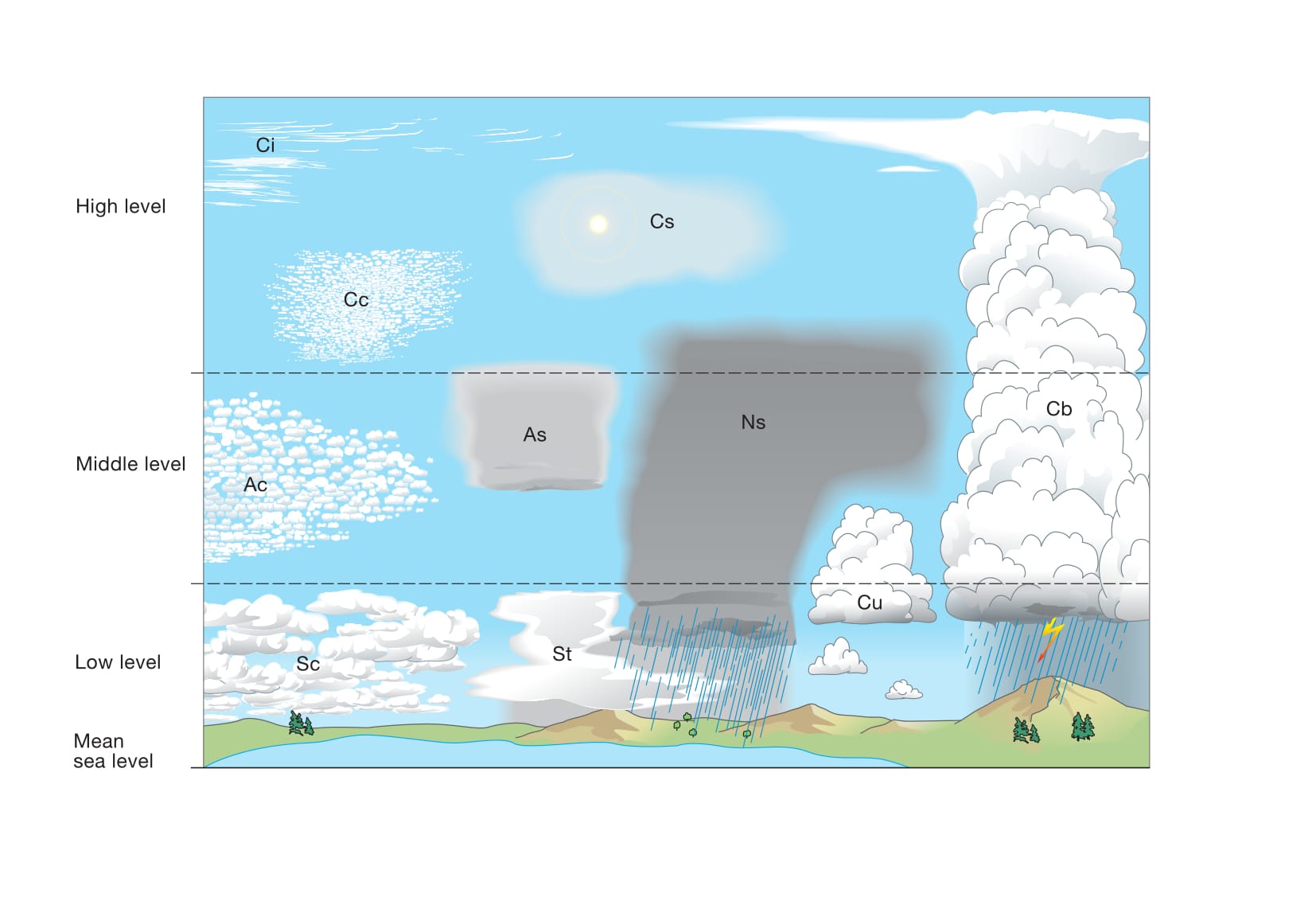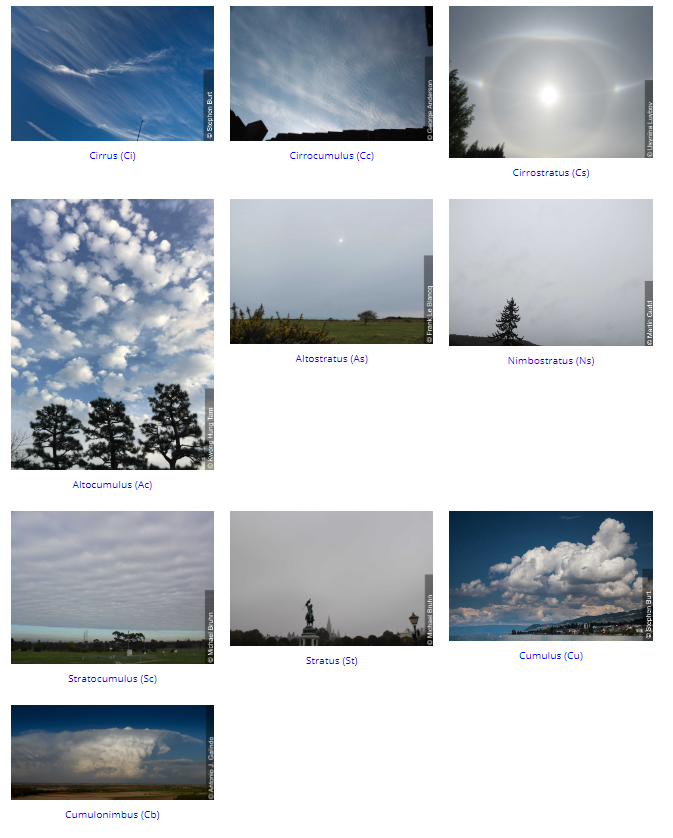
Clouds 雲
Ref: https://cloudatlas.wmo.int/en/clouds.html
雲係一種同水有關既大氣現象
A cloud is a hydrometeor consisting of minute particles of liquid water or ice, or of both, suspended in the atmosphere and usually not touching the ground. It may also include larger particles of liquid water or ice, as well as non-aqueous liquid or solid particles such as those present in fumes, smoke or dust.
Distinguish clouds by levels
Clouds are generally encountered over a range of altitudes varying from sea level to the top of the troposphere (i.e the tropopause).

Table 6. Approximate heights of each level, and the genera occurring in each. (Information from WMO)
| Level | Genera | Polar region | Temperate region | Tropical region |
| High | Cirrus Cirrocumulus Cirrostratus |
3 – 8 km (10 000 – 25 000 ft) |
5 – 13 km (16 500 – 45 000 ft) |
6 –18 km (20 000 – 60 000 ft) |
| Middle | Altocumulus Altostratus Nimbostratus |
2 – 4km (6 500 – 13 000 ft) |
2 – 7 km (6 500 – 23 000 ft) |
2 – 8 km (6 500 – 25 000 ft) |
| Low | Stratus Stratocumulus Cumulus Cumulonimbus |
From the Earth’s surface to 2 km (0 – 6 500ft) |
From the Earth’s surface to 2 km (0 – 6 500ft) |
From the Earth’s surface to 2 km (0 – 6 500ft) |
Most clouds are confined within their level with the following few notable exceptions:
(a) Altostratus is usually found in the middle level, but it often extends higher;
(b) Nimbostratus (Ns) is almost always found in the middle level, but it usually extends into the other two levels;
(c) Cumulus and Cumulonimbus (Cb) usually have their bases in the low level, but their vertical extent is often so great that their tops may reach into the middle and high levels.
When the height of a particular cloud is known, the concept of levels may be of some help to the observer in identifying the cloud. The genus can be determined by making a choice from among the genera normally encountered in the level corresponding to its height.
Distinguish clouds by Genera
Consideration of the most typical forms of clouds leads to the recognition of (10) ten genera. The definitions of the genera given below do not cover all possible aspects, but are limited to a description of the main types and of the essential characteristics necessary to distinguish a given genus from genera having a somewhat similar appearance.
High level: Ci, Cs, Cc
Medium level: As, Ac, Ns
Low level : Sc, St, Cu, Cb
- Cirrus (Ci) – High level
- Detached clouds in the form of white, delicate filaments or white or mostly white patches or narrow bands. These clouds have a fibrous (hair-like) appearance, or a silky sheen, or both
- (related to) in advance of an occluded front
- Cirrocumulus (Cc) – High level
- Thin, white patch, sheet or layer of cloud without shading, composed of very small elements in the form of grains, ripples, etc., merged or separate, and more or less regularly arranged; most of the elements have an apparent width of less than 1°.
- Cirrostratus (Cs) – High level
- Transparent, whitish cloud veil of fibrous (hair-like) or smooth appearance, totally or partly covering the sky, and generally producing halo phenomena.
- Altocumulus (Ac) – Medium level
- White or grey, or both white and grey, patch, sheet or layer of cloud, generally with shading, composed of laminae (a layer or layers), rounded masses, rolls, etc., which are sometimes partly fibrous or diffuse and which may or may not be merged; most of the regularly arranged small elements usually have an apparent width of between 1° and 5°.
- Altostratus (As) – Medium level
- Greyish or bluish cloud sheet or layer of striated (grooves or channels in cloud formations, arranged parallel to the flow of the air), fibrous or uniform appearance, totally or partly covering the sky, and having parts thin enough to reveal the Sun at least vaguely, as through ground glass or frosted glass
(a grey featureless layer of clouds with great horizontal extent covering almost the whole sky) - Altostratus does not show halo phenomena.
- Greyish or bluish cloud sheet or layer of striated (grooves or channels in cloud formations, arranged parallel to the flow of the air), fibrous or uniform appearance, totally or partly covering the sky, and having parts thin enough to reveal the Sun at least vaguely, as through ground glass or frosted glass
- Nimbostratus (Ns) – Medium level
- Grey cloud layer, often dark, the appearance of which is made diffuse by more or less continuously falling rain or snow, which in most cases reaches the ground. It is thick enough throughout to blot out the Sun (i.e the cloud is thick enough throughout to obscure the Sun).
- Low, ragged clouds frequently occur below the layer, with which they may or may not merge.
- Stratocumulus (Sc) – Low level
- Grey or whitish, or both grey and whitish, patch, sheet or layer of cloud that almost always has dark parts, composed of tessellations, rounded masses, rolls, etc., which are non-fibrous (except for virga) and which may or may not be merged; most of the regularly arranged small elements have an apparent width of more than 5°.
- Stratus (St) – Low level
- Generally grey cloud layer with a fairly uniform base, which may give drizzle, snow or snow grains. When the Sun is visible through the cloud, its outline is clearly discernible. Stratus does not produce halo phenomena except, possibly, at very low temperatures.
- Sometimes Stratus appears in the form of ragged patches.
- Cumulus (Cu) – Low level
- Detached clouds, generally dense and with sharp outlines, developing vertically in the form of rising mounds, domes or towers, of which the bulging upper part often resembles a cauliflower. The sunlit parts of these clouds are mostly brilliant white; their bases are relatively dark and nearly horizontal.
(White cloud – blue sky)
- Detached clouds, generally dense and with sharp outlines, developing vertically in the form of rising mounds, domes or towers, of which the bulging upper part often resembles a cauliflower. The sunlit parts of these clouds are mostly brilliant white; their bases are relatively dark and nearly horizontal.
- Cumulonimbus (Cb) – Low level
- Heavy and dense cloud, with a considerable vertical extent, in the form of a mountain or huge towers. At least part of its upper portion is usually smooth, or fibrous or striated, and nearly always flattened – this part often spreads out in the shape of an anvil or vast plume.
- Under the base of this cloud, which is often very dark, there are frequently low ragged clouds either merged with it or not, and precipitation sometimes in the form of virga.
Calendar
| S | M | T | W | T | F | S |
|---|---|---|---|---|---|---|
| 1 | ||||||
| 2 | 3 | 4 | 5 | 6 | 7 | 8 |
| 9 | 10 | 11 | 12 | 13 | 14 | 15 |
| 16 | 17 | 18 | 19 | 20 | 21 | 22 |
| 23 | 24 | 25 | 26 | 27 | 28 | 29 |
| 30 | ||||||
Archives
- November 2025
- October 2025
- September 2025
- August 2025
- July 2025
- June 2025
- May 2025
- April 2025
- March 2025
- January 2025
- December 2024
- November 2024
- October 2024
- September 2024
- August 2024
- July 2024
- June 2024
- May 2024
- April 2024
- March 2024
- February 2024
- January 2024
- December 2023
- November 2023
- October 2023
- September 2023
- June 2023
- May 2023
- April 2023
- March 2023
- July 2022
- May 2022
- April 2022
- August 2021
- April 2021
- March 2021
- February 2021
- December 2020
- November 2020
- October 2020
- September 2020
- August 2020
- July 2020
- June 2020
- May 2020
- April 2020
- March 2020
- February 2020
- January 2020
- December 2019
- September 2019
- June 2019
- May 2019
- April 2019
- March 2019
- February 2019
- January 2019
- December 2018
- November 2018
- October 2018
- July 2018
- June 2018
- May 2018
- April 2018
- March 2018
- February 2018
- January 2018
- December 2017
- November 2017
- October 2017
- September 2017
- June 2017
- March 2017
- January 2017
- December 2016
- August 2016
- July 2016
- June 2016
- May 2016
- April 2016
- March 2016
- January 2016
- December 2015
- November 2015
- October 2015
- September 2015
- March 2014
- September 2013
- August 2013
- March 2013
- September 2012
- August 2012
Categories
- AFTC training
- AGK – Airframe, Engine, System
- AGK – Instruments
- ATPL Knowledge
- Aviation
- Aviation English
- BAK
- BC Life in CTB
- Book Sharing
- Books of OSH
- Cathay Pacific
- CNY Trip 2019
- CNY trip 2020 (Malaysia)
- Coffee
- Communication
- Corporate Governance
- English Learning
- Environmental Management
- ERM (enterprise risk management)
- Excel
- First Step Summit
- Flight International (Magazine)
- Flight planning and Monitoring
- HKMA ADMS
- Human Performance and Limitations
- Introduction to OHS
- IT
- Korea Trip 2019
- Learn from aviation accident
- Legislative Context in OHS
- London + Paris 2013
- Macau @ Trip 2017
- Meteorology
- Microsoft Windows
- MOLDOVA CHALLENGE
- My Diaries
- My Travels
- Navigation
- Occupational Health and Safety (OSH)
- Operational Procedures
- Operations Management
- Organizational Behavior
- OSH English
- Power BI
- Preparation
- Principal of Flying
- Python
- Quality Management System (QMS)
- Radio Navigation
- Regulations, Rules and Practices
- Risk Assessment
- Road to be an airline cockpit crew
- Route Training
- Summer Trip 2018
- Taiwan trip 2016
- The life in VHHH
- The road to be a pilot
- The road to be a RSO
- Uncategorized
- Weight & Balance
- Wine
- 學車 in CTB
- 私牌系列
- 馬來西亞 (怡保+檳城) 2024

